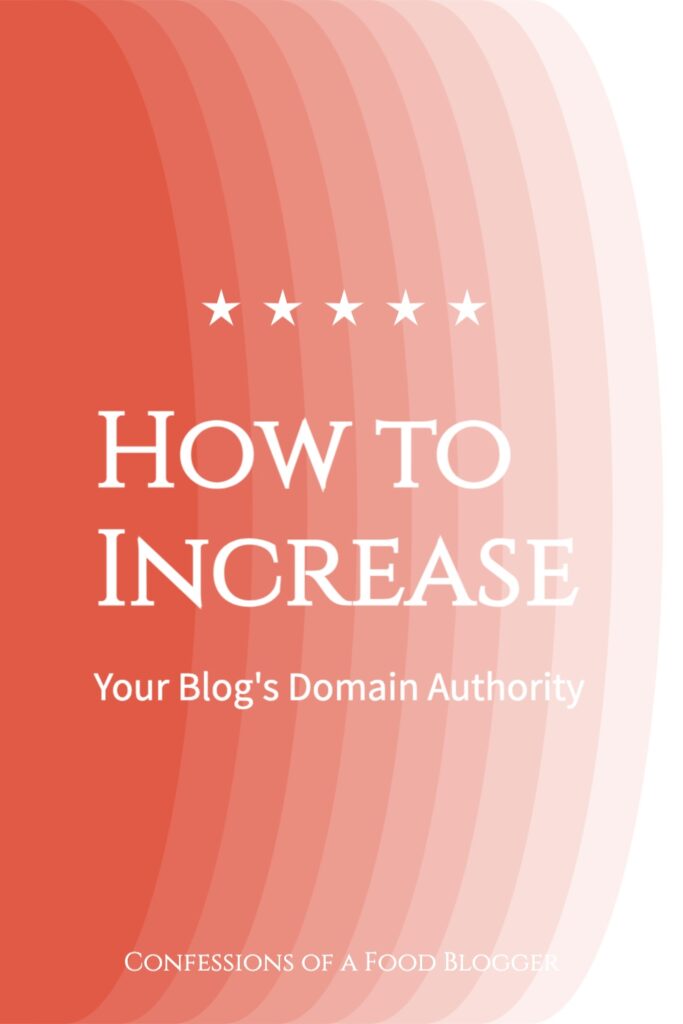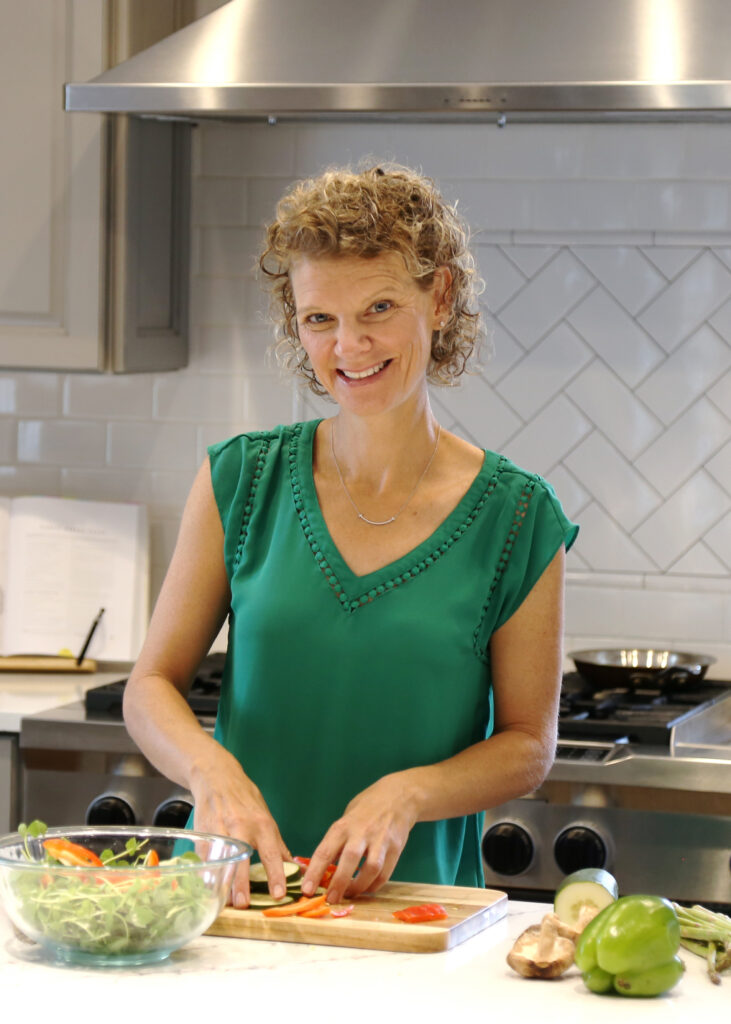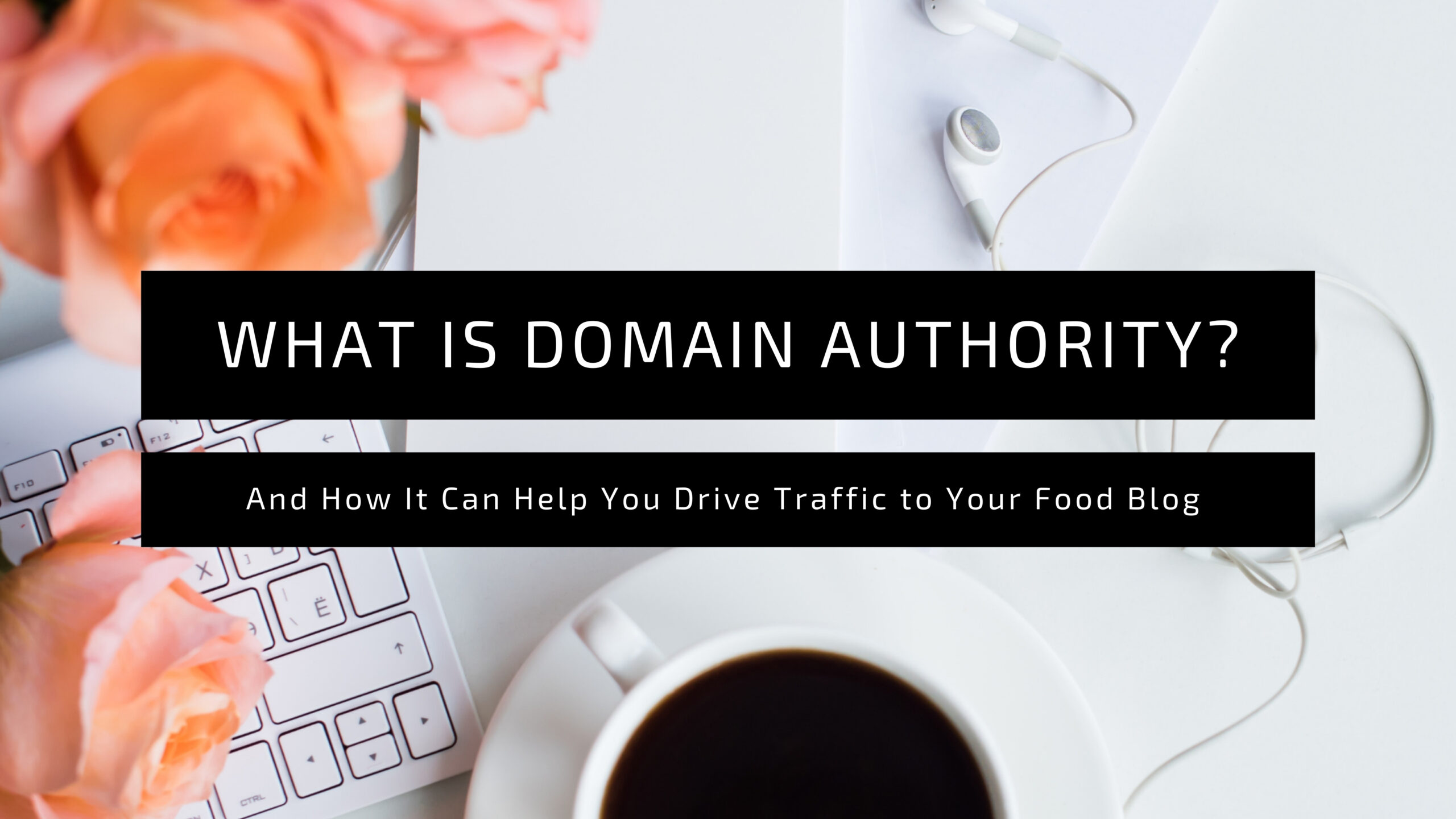What is Domain Authority?
This What is Domain Authority blog post includes affiliate links. When I find a great product or service, I like to share it with my readers. Sometimes I use affiliate links so I can earn a commission for my recommendations. Thank you for your support!
Wondering How You Can Increase Your Google Search Engine Results? You Need to Understand Domain Authority
If you’re a food blogger, you’ve probably asked yourself this question: how do I get my food blog posts to rank on Google? And by rank, you probably meant within the first 10 search results. And then you probably thought: I’m just a small [insert niche] blog, ranking on the first page of Google can’t happen for me, right?
Well, no. That’s actually wrong.

Achieving a high ranking in Google’s search engine results can be a major force in driving traffic to your blog. And it’s not out-of-bounds for smaller food bloggers to seek to rank in the top 10 Google Search Engine Results.
It does require some finesse though, and that’s what this Confessions of a Food Blogger blog post is about.
Why You Should Care About Generating Organic Traffic
Many food bloggers are daunted by the time and energy it takes to rank well in Google’s search engine results. It’s especially hard to focus on an organic search engine ranking when you’re being pulled in a dozen different directions. For example, trying to build up your Instagram engagement or seeking that viral Pinterest magic, just to name a few.
And while the dopamine hit from a social media win feels wonderful. And the surge of traffic to your blog is definitely a rush, relying on social media to drive traffic to your blog is a lot like chasing your tail. The results are short-lived and you’re back to the drawing board in short order.
By contrast, focusing on your ranking in Google’s search engine results has some serious staying power. It can deliver traffic to your blog over the long term. The work a slog, but it is where you should be putting most of your food blogging energy. IMHO.
So how to you do it?
Increasing Organic Traffic to Your Food Blog
If you’ve been in the food blogging space for any length of time, I am sure that you know that a lot of success in organic ranking comes down to choosing the right keywords and key phrases. You probably already know that you need to find relevant high volume and low competition keywords. And then you need to populate each of your blog posts with them.

If you’re scratching your head, take a minute to read up on my Blogger’s Guide to SEO Keyword Research post. This will give you the basics on selecting keywords and key phrases for your blog pages and posts.
What you probably didn’t know was that there’s a very important underlying factor that makes certain keywords and key phrases right for you. And that’s called your domain authority.
What is Domain Authority?
Domain authority, also called domain rating, website authority and trust authority, is a ranking that — simply put — identifies how trustworthy your food blog is in Google’s eyes.
Google’s algorithm — which dictates what search results get put in front of a user — heavily weighs a website’s trustworthiness. That is to say, if a user searches for chicken pot pie recipes, can Google trust that if it sends that user to your website, that user will find that they’re looking for?

This is incredibly important to Google. The more times that Google can do that, the more the public will trust it as a resource. And, over time, delivering spot-on results will (or arguably has) made Google the ultimate online matchmaker.
Domain authority, while complicated, gets boiled down to a number between 1 and 100. It’s important to recognize when you’re looking for your blog’s domain authority, the number that you see isn’t a Google-generated number. It’s an independent assessment by a third-party based on what that party thinks Google of your trustworthiness.
Real Life Examples of Domain Authority
Like trust in any situation, building it takes time and so does increasing your domain authority. New food blogs often start out in the single digits (with a 1, 2 or 3). This is because Google simply doesn’t have enough information to know whether a new blog is a trustworthy resource.
Established food blogs, like Pinch of Yum and the Minimalist Baker — to use a couple of food blog examples — have domain authorities of 69 and 75, respectively. And behemoths like Facebook, CNN and Home Depot have domain authorities 96, 95 and 90, respectively. But having a brand like Home Depot isn’t required. Small blogs and websites can have really high domain authorities as well. In fact, one of my older websites has a domain authority of 93. [But see Setting Expectations for Your Domain Authority below).
What is a Good Domain Authority?
Now, before you panic, this exercise isn’t intended to make you feel hopeless. Herbivore’s Kitchen’s domain authority, to date, is 24. Feel better?
Yes, there are good and better domain authorities, but a low domain authority isn’t necessarily bad. And even though it might sting when you first get the news, remember – it isn’t personal. It likely just means that you’re a young food blog and Google just needs to learn that it can trust you.

Want to learn how to check your domain authority AND use that information to conduct solid keyword research? I cover it all in my Food Blogger’s Guide to SEO mini course.
How to Use Your Domain Authority & Setting Your Domain Authority Expectations
Once you have your domain authority, you should write every food blog page and post with it in mind.
Yes, it’s harder to find those keywords and key phrases. But… the good news is, if you do it right when you’re in the Little League, you’ll eventually work your way up to JV (probably) or varsity (maybe). Just know that getting to 100 isn’t the goal. Amazon isn’t even at 100.
The goal is to always play within the bounds of your domain authority. In practice, this means choosing keywords and key phrases with difficulty levels around your domain authority. It doesn’t mean picking only those that are at your domain authority or lower. Remember, your domain authority as you see it isn’t a Google generated number, so it’s possible that Google views you more favorably than your assigned domain authority would suggest.
For example, even with a domain authority of 17, Herbivore’s Kitchen ranks for many keywords with a competition level of 30+.
How Do You Increase Your Domain Authority?
Building up an arsenal of food blog posts that rank highly on Google will help to increase your domain authority.
Paying attention to your food blog’s health is important as well. For example, do your pages load quickly or is your blog clunky and cumbersome? Is your blog mobile friendly?

The real factor though, it seems, is called a backlink.
A backlink is a link from another website that links back to a page on your food blog. The more highly ranked (i.e. the higher the domain authority) the linking site is, the more powerful the backlink will be. In other words, Google assumes that if a highly trustworthy website is citing you for information, then your blog must be trustworthy as well.
Unfortunately, backlinks used to be pretty easy to get. It used to be that each Pinterest Pin that linked back to your food blog operated as a backlink. The same was true with other social media outlets as well. But Google has cracked down on those over the years and refined its backlink “rule” to be more authentic (i.e. relying on measures that were not generated by the website’s owner).
Moveover, a backlink has diminishing returns if it comes from the same source. That is, if you collect a large number of backlinks from the same source, each one will be less effective than the last. So, getting one of your recipes listed on a recipe aggregator is great for the first backlink, but having 20 recipes listed won’t deliver the same results.
Backlinks may also explain are why you occasionally get an email from a fellow food blogger or a marketing agency asking if they can write a guest post on your food blog. It’s not because they have extra time on their hands. It’s because they want that post to backlink to their own blog, thereby driving up their domain name. This isn’t a bad tactic – in fact, it’s one of the most effective organic approaches. It is long and tedious though and you need to be sure that it is original content and relevant to your offerings.
Final Thoughts on Domain Authority
While it’s tempting to go after your domain authority like a dog with a bone, you need to remember that it grows slowly by design. My recommendation is to relax a bit about increasing your domain authority and work on the things that are within your control – like choosing competitive keywords and key phrases. Over time, this will increase your domain authority.
You can also leverage social media to build your backlinks. Just by being a regular contributor of well-developed and entertaining blog posts, you’ll be encouraging others to view you as a resource. And, as such, they may naturally link their blogs up to yours.
About Confessions of a Food Blogger

Kate Friedman is the creator of Herbivore’s Kitchen, a vegan food blog, and Confessions of a Food Blogger. Confessions of a Food Blogger is an informative resource for food bloggers (and, actually all bloggers) that provides helpful articles, online courses and tips and tricks for starting, building, marketing and managing a food blog.


